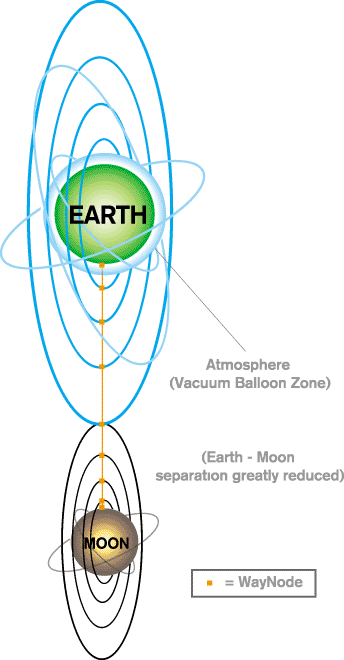Blue-skies thinking re the HydroSolar Package
David Noel
<davidn@aoi.com.au>
Ben Franklin Centre for Theoretical Research
PO Box 27, Subiaco, WA 6008, Australia.
Summary
This web article contains rather more speculative ideas on possible future developments with The HydroSolar Package described at [18], http://www.aoi.com.au/bcw/HydroSolar.htm. They are presented separately as they do not form part of the main package.
Hydrogen ducting in floating sleeves
The fact that hydrogen is the lightest possible gas opens up some interesting possibilities for its transport.
Hydrogen could be ducted from remote areas in thin-walled flexible sleeves which would naturally float. Occasional tie-lines, tethering these sleeves to the ground while allowing them to float out of reach of normal traffic, would be all that was needed.
Solar cells floating above ground: the SkyWeb
Instead of laying solar cells out on the ground, these could be suspended on a network of normal or vacuum balloons [14], high in the sky and so not using up any land -- a SkyWeb.
This concept could be extended in various ways. Because a SkyWeb structure would be generating hydrogen, this hydrogen could be incorporated into the structure of the SkyWeb to maintain it at the desired altitude.
The SkyWeb could draw the water needed for electrolysis from adjacent clouds. Any cloud can be a source of water, a cloud is only a mist high above the land surface, and a mist net will collect water.
Rain clouds have their bases at a height of around 2 km [15]. Very extensive SkyWeb structures might be maintained at a height of 3 km or more, where they would be above low clouds which would block sunlight. The structures might be transparent and have a reticulated pattern, so that they would block off no more than, say, 10 percent of sunlight from the ground below.
Reducing Global Warming by raising reflectivity
On the other hand, it might be thought desirable to mount the SkyWeb solar cells on a shiny metallic surface. Light not absorbed by the cells would be reflected back into space. This would increase the Earth's reflectivity ('albedo') and reduce global warming. A developed SkyWeb could influence Earth's weather and climates.
SkyWebs above seas or agisted over other countries
The SkyWeb could be deployed over seas and oceans, as well as land. There could be a commercial market for countries to rent out the airspace above their lands and seas.
SkyWebs in the HydroWeb for international hydrogen transport
Moreover, the SkyWeb would form a natural part of the HydroWeb, so that hydrogen could be transferred from one country to another over it.
Hydrogen production without photocells
A recent article [17] describes how bacteria can be used to generate hydrogen from confectionary waste, this hydrogen being fed directly into a fuel cell. Obviously the fuel cell could be omitted, with hydrogen fed directly into the HydroWeb.
Monatomic Hydrogen
An interesting theoretical concept is the use of Monatomic Hydrogen as a fuel. Hydrogen normally consists of molecules, each containing two atoms of hydrogen. If hydrogen could be maintained as separate atoms instead of molecules, this substance would have a very high calorific value, as a great deal of energy is released when atoms combine. However, at present no way is known to create and store any significant amount of monatomic hydrogen.
Hydrogen Fusion
Another theoretically attractive way of extracting energy from hydrogen is by 'controlled fusion', where atoms of hydrogen are fused together to make helium atoms. This releases a tremendous amount of energy through conversion of matter, and is the source of energy in hydrogen bombs. But to date, no way has been found to do this conversion in a controlled way which gives a net energy output.
Extending the HydroWeb outside the Earth's atmosphere
Although the main article supposes that the HydroSolar Package will deliver plentiful cheap energy sufficient to meet present and future demands, the availability of a large energy source inevitably raises applications wanting to use even more of it.
What if energy demands start to overtake the one-thousandth of the supply which at present seems usable without impacting on the planet's natural functions of powering plants and climate systems?
This is perhaps in the realm of science fiction, but the disc which the Earth presents to the sun is only a miniscule fraction of the sphere over which the Sun radiates.
More of this energy sphere could be tapped by huge but light inflated satellites, orbiting up to a million kilometres from Earth, but connected to it by a Space Web [16].

The Space Web concept. From [16]
In this way, the HydroSolar package might be extended beyond the Earth's atmosphere, even as far as the Moon. But that perhaps is a matter for distant future civilizations!
References and Links
[14] The Vacuum Balloon. . www.aoi.com.au/bcw/VacuumBalloon.htm.
[15] Clouds. www.fi.edu/wright/again/wings.avkids.com/wings.avkids.com/Book/Atmosphere/instructor/clouds-01.html.
[16] Space Webs, a potential framework for pumping material from the Earth to the Moon. www.aoi.com.au/pandora/frames3638.htm.
[17] (Hydrogen from E. coli drives fuel cell).www.biochemsoctrans.org/bst/033/bst0330076add.htm.
[18] The HydroSolar Package. www.aoi.com.au/bcw/HydroSolar.htm.
***********
(end)
Go to BCW Main Page
Interim version 0.9 on Web 2006 Sep 14
Version 1.0 on Web 2006 Sep 14
Version 1.1 (minor corrections) on Web 2006 Sep 23


